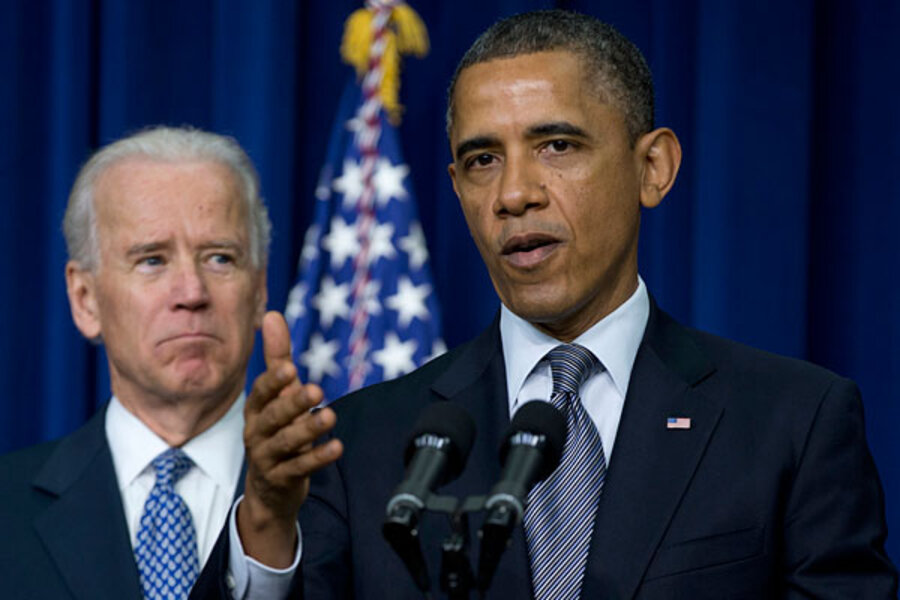Gun control 101: Why is Obama pushing for new gun research?
Loading...
| Washington
This week President Obama outlined a sweeping package of proposed changes to America’s gun laws, including a federal ban on the manufacture and sale of new assault weapons and an expansion of background checks on firearm purchasers. But proponents of gun control say one of the most important pieces of the plan may be a smaller, less-noticed move: Mr. Obama’s attempt to end a 15-year ban on federal research into guns and violence.
For years, some members of Congress have effectively blocked the Centers for Disease Control and Prevention and other federal agencies from conducting such research due to concerns about pro-gun control bias. On Wednesday, Obama said he’d use the powers of the presidency to change that situation.
“While year after year those who oppose even modest gun safety measures have threatened to defund scientific or medical research into the causes of gun violence, I will direct the Centers for Disease Control to go ahead and study the best ways to reduce it.... We don’t benefit from ignorance,” said Obama.
Here are some basic questions and answers about the research issue:
What's stopping the government from studying guns and violence?
In 1996 some conservative members of Congress mounted an effort to eliminate the CDC’s National Center for Injury Prevention and Control because they believed some researchers were cheerleaders for the anti-gun movement. In the end, they took the $2.6 million this center had spent on gun research the previous year, and earmarked it for brain-injury research. In addition, Congress added language to the CDC appropriation saying “none of the funds made available for injury prevention and control at the Centers for Disease Control and Prevention may be used to advocate or promote gun control.”
It’s unclear exactly what sorts of things this phrase prohibits. But no federal employee was willing to risk their career to find out, according to a December Journal of the American Medical Association article. Several years later, Congress made the language applicable to the Department of Health and Human Services, as well.
“Even today, 17 years after this legislative action, the CDC’s website lacks specific links to information about preventing firearm-related violence,” says the article by Arthur Kellermann and Frederick Rivara.
Generally speaking, gun-rights organizations oppose treating firearms as a public-health issue, as opposed to a constitutional right.
What don't we know?
This congressional prohibition did not end the study of guns in America, of course. The federal government does not fund all of the nation’s social research. In addition, the Bureau of Alcohol, Tobacco, and Firearms, as well as the Federal Bureau of Investigation, continue to estimate statistics such as the percentage of homicides committed with firearms.
What are missing are more expansive studies, according to a recent Congressional Research Service report.
“None of the existing sources of statistics provide either comprehensive, timely, or accurate data with which to assess definitively whether there is a causal connection between firearms and violence,” writes CRS’s William Krouse.
Other researchers say that right now the US has little information on basic gun topics, such as how many people own what sorts of guns in what cities and states. There is not much good information on the correlation of gun ownership to homicide rates, or what percentage of guns used in crimes were obtained legally, and if not, where they came from.
“Without improvements in this situation, the substantive questions in the field about the role of guns in suicide, homicide and other crimes, and accidental injury are likely to continue to be debated on the basis of conflicting empirical findings,” concluded an in-depth 2005 National Research Council study of the state of firearms and violence data.
What did Obama do on this subject?
On Wednesday, Obama vowed to end the “freeze” on gun-violence research. Among other things, he issued a presidential memorandum directing CDC and other US scientific agencies to conduct research into the causes and prevention of such crimes.
Obama said he based this move on a legal analysis that the existing appropriations language does not block wide-ranging investigations.
“The CDC will start immediately by assessing existing strategies for gun violence and identifying the most pressing research questions, with the greatest potential public health impact,” reads a fact sheet on the president’s gun plan.
Obama also called on Congress to appropriate $10 million to CDC for further work, including an effort to better understand the relationship between video games, media images, and violence. And he asked for another $20 million to expand the National Violent Death Reporting System, which collects anonymous data on the nature of firearms used in murders or suicides, to all 50 states from its current 18.
Will Obama's moves work?
His call for the CDC to dive into research is simply a legal analysis that it is all right for them to do so under current law. That is within his power to order, though it remains to be seen how eagerly CDC will take up the banner, and whether pro-gun groups will file suit to try and stop it.
As to his calls for Congress to direct more cash to this area, good luck. It is possible that members will see this as a less controversial alternative to more sweeping measures such as the proposed assault-weapons ban. It is also possible that the current tight fiscal environment will allow Capitol Hill to shuffle the suggestions aside.





